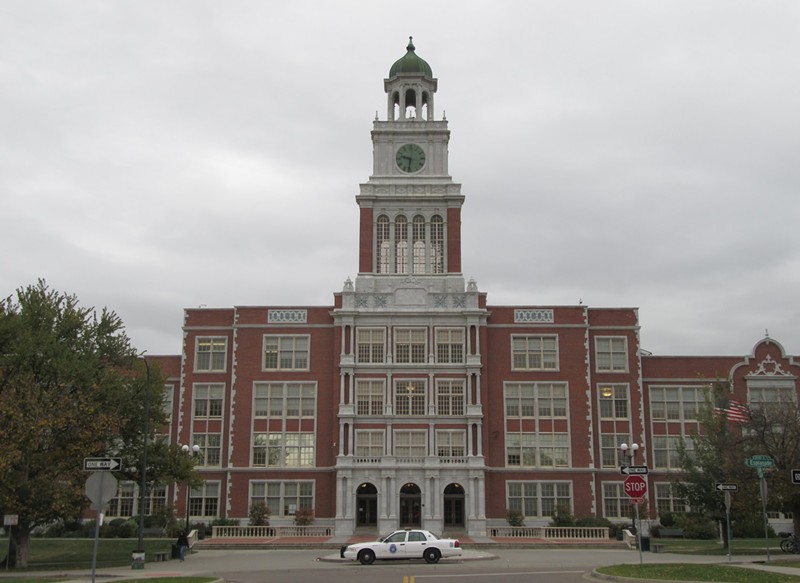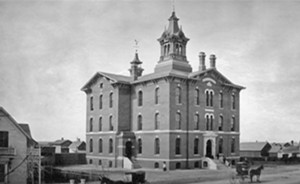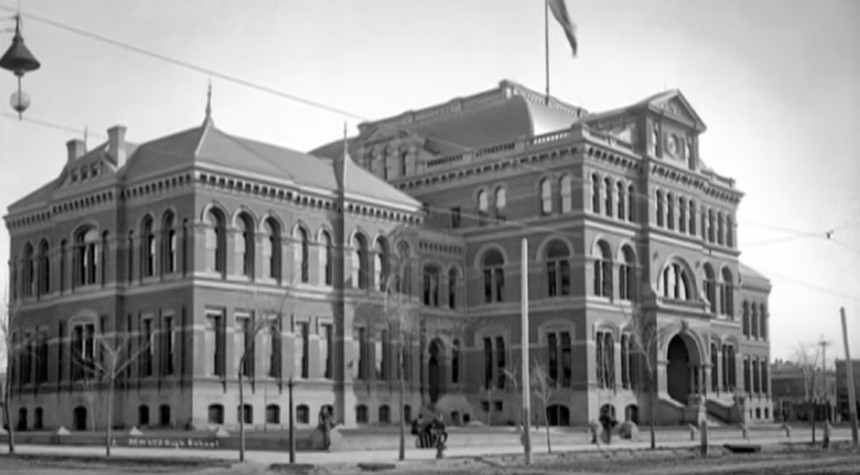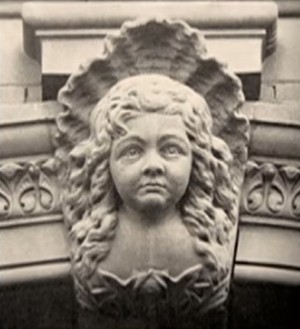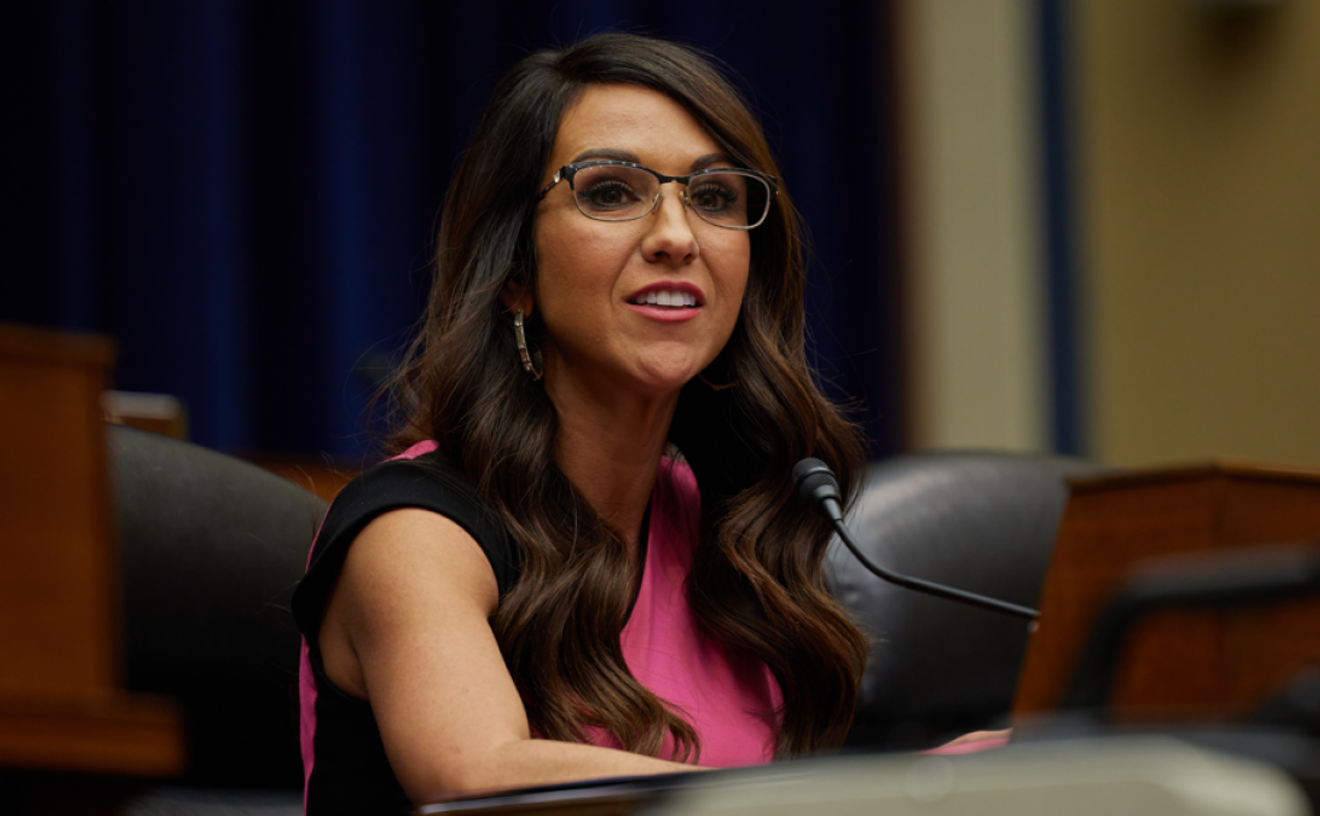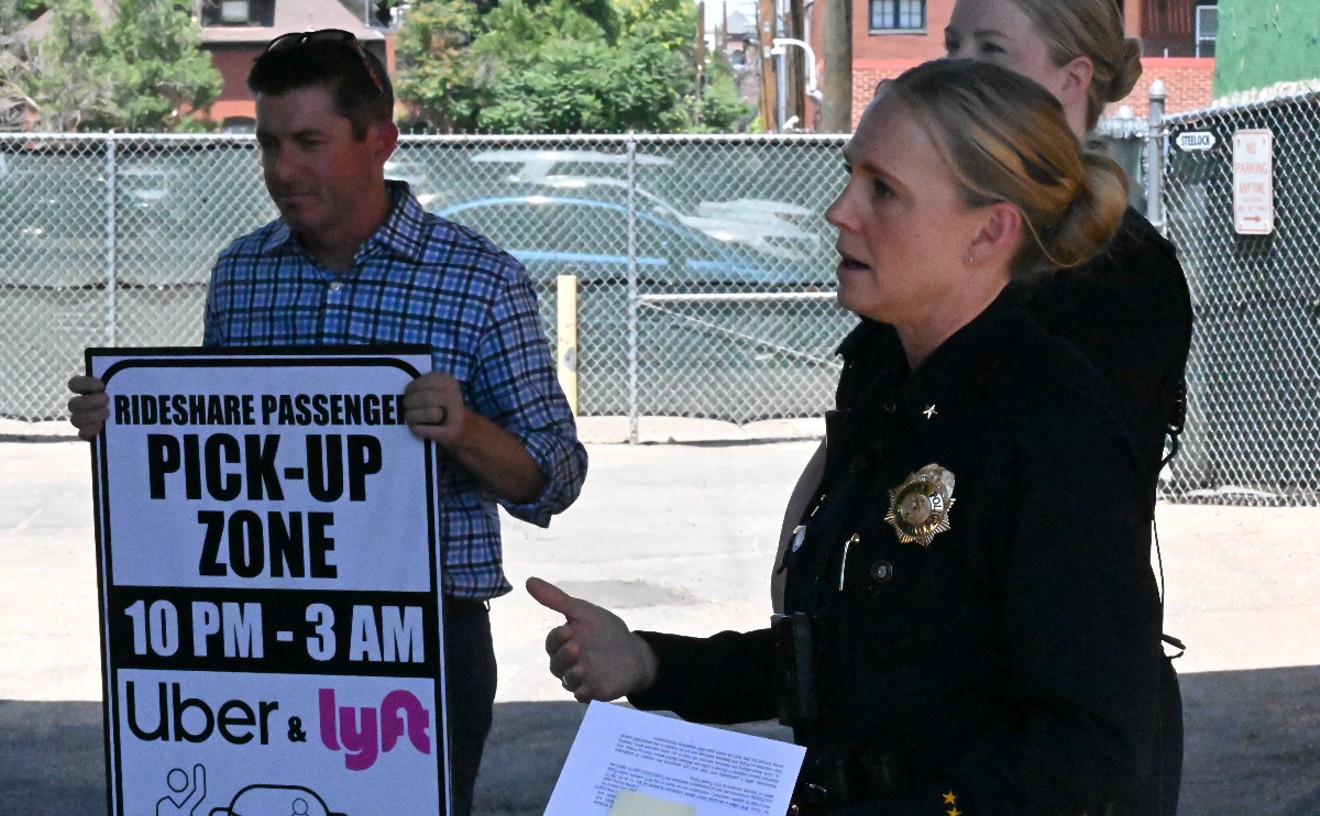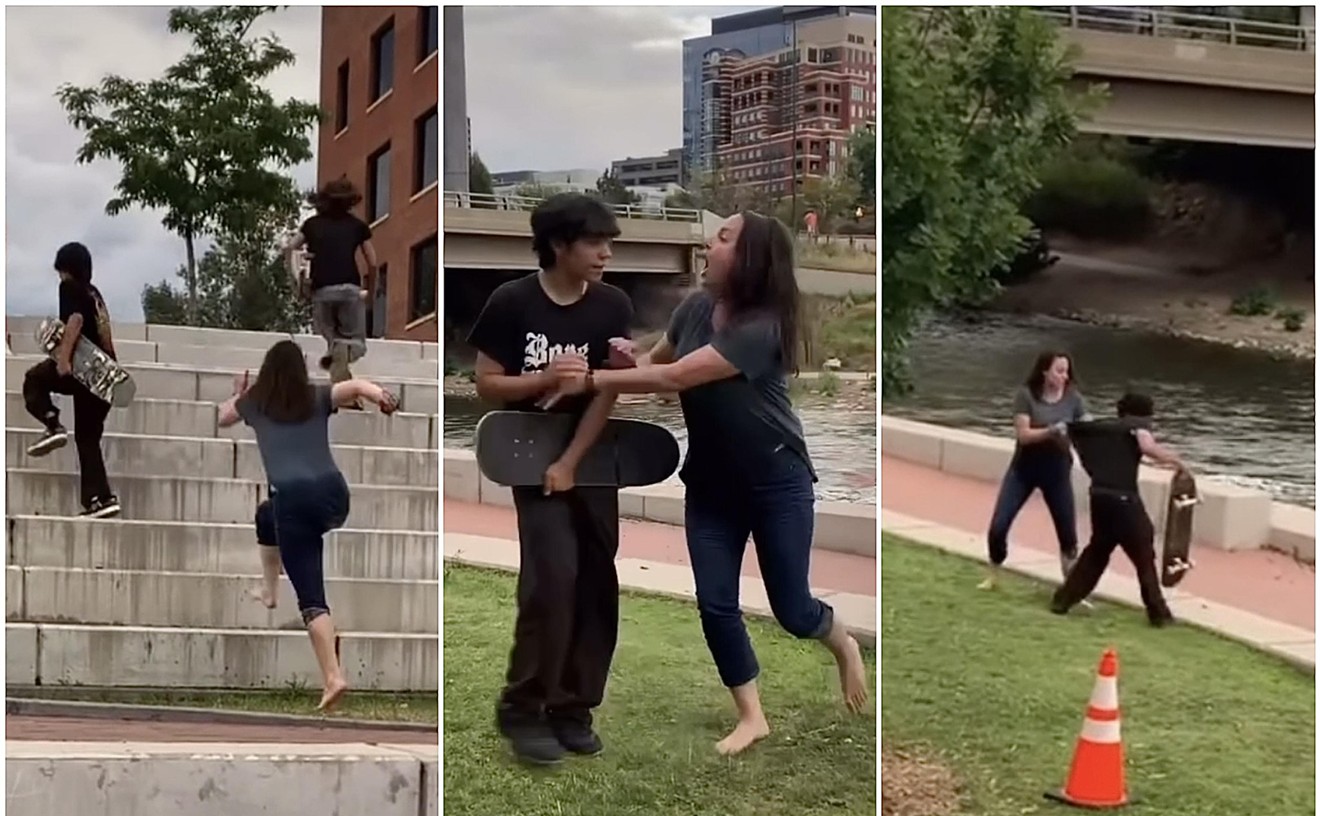East High hasn’t always been East High. Despite its service as the consistent center of Denver secondary education from the city’s earliest years, it took a while for the school to develop into an architectural jewel and the beating angelic heart of Denver students.
It began, according to East High’s own website, as a “leaky, mud-roofed, one-room log cabin schoolhouse” that sat on 12th Street near Market Street in 1859 — so far back that Market was still named McGaa Street. (William McGaa was a founder of Denver, but also a violent drinker who’d sullied his name so badly by 1866 that the burgeoning city changed the street's name, and not for the last time.) This proto-East High was called “The Union School,” and enrolled thirteen children its first year.
The Union School was private, as were all of the schools that germinated in Denver as the settlement established itself. In 1861, the new territorial government established the office of Superintendent of Schools that oversaw two Denver districts: East and West, with Cherry Creek dividing them.
But construction of the first public school would take eleven years — there was no money to build. In 1872, the Arapahoe School was built for Denver’s new District 1, named for the street on which it sat between 17th and 18th streets. It graduated its first class of students in 1877, when the school population (including seven seniors) voted to establish the school colors: white and carmine, a deep purplish-red that was, perhaps not coincidentally, the only colored ink available in Denver at the time.
The Arapahoe School is considered to be the real start of East — James H. Baker was hired in 1875 to serve as principal, and he’s considered the first East principal — but the school only lasted in that location until 1882. Owing to the rapid economic growth of the surrounding downtown blocks, the land was considered too valuable for a school, and it was sold. The building became part of the Club Building, which itself was torn down in 1955.
According to Denver historian Tom Noel, in 1882 the East student body moved to a new home at 19th and Stout streets, which doubled as the Denver Public Library. The three-story Romanesque structure was celebrated as an architectural triumph, and its beauty led to the association with angels: Architect Robert S. Roeschlaub decided to use a Denver student as the model for the face of a young girl sculpted at the school entrance. It was meant to symbolize the new school’s “dedication to youth,” and more than 5,000 girls were considered for the model. Six-year-old Ella Catherine Matty won the right to have her image ensconced on what later came to be called “Old East,” and inspired all East students thereafter to be referred to as “Angels.”
Old East lasted until 1925, when the East High School we know today was finished; it was demolished to make room for the Federal Building and U.S. Custom House that still sit with equal majesty on the site today.
East High — “New East,” for those who still recalled the former building — was of even greater architectural significance than the school it replaced. An East graduate designed the building at 1600 City Park Esplanade, near the corner of Colfax and Detroit streets. George Hebard Williamson, who also helped design the Daniels & Fisher Tower, chose to pattern the structure after elements of both Independence Hall in Philadelphia and Old Hall at the University of Oxford in England. The inclusion of light-admitting elements was central to his concept, including tall exterior windows and interior windows meant to flood the central hallways with light. (These interior windows — as well as the decorative, amber-colored glass panes in the original auditorium — were all eliminated because of fire codes in the 1950s.) The most notable element of the design is arguably the central clocktower, with a large room made primarily of windows just below the mechanism. In 1989, that space was turned into the “Tower History Room,” a gallery of sorts devoted to the preservation and display of East High’s history.
Other remnants of earlier schools have been saved, too. The bell that once called students to class in the original Arapahoe School now sits on the south lawn. The keystone angel from Old East was placed in a memorial rock garden (now essentially unrecognizable after many years of weather erosion), while a replica was installed on the second floor. The magnificent library on the third floor hosts a number of busts relocated from Old East as well, sentried along the wall under the New Deal-era Hugh Weller murals titled "The Travels of Marco Polo."
It’s not just the buildings that have housed East High over the more than a century and a half of its existence that are noteworthy; the list of alumni includes many famous names. Actors Ward Bond, Don Cheadle, Pam Grier, Harold Lloyd, Hattie McDaniel, T.J. Miller and Douglas Fairbanks (who was actually expelled) all attended classes at East. Carl Caldwell, Philip Bailey and Larry Dunn from Earth, Wind & Fire matriculated there, as did songstress Judy Collins and guitarist Bill Frisell. Legendary writer and TV creator Sidney Sheldon, Beat poetry icon Neal Cassady, Broadway star Antoinette Perry (for whom the Tony Awards are named), and Apollo 13 astronaut Jack Swigert were all Angels. Add to that an impressive number of athletes, politicos, military men, even a Miss America — and you’d still have an incomplete list. Retired East High English teacher Richard Nelson’s book Flight of Angels suggests that the number of celebrity graduates at this point is well over 100 strong and counting.
While members of The Fray are sometimes incorrectly labeled as East High grads, none of the musicians in the Colorado band went to school there — but they did film the video for their hit song “Over My Head (Cable Car)” at East in 2005.
East High was designated a Denver Historic Landmark in 1991; it consistently ranks high on both local and national lists of the best public high schools. Denver East hockey won not just the state championship but its first-ever national championship in 2022; the debate team makes regular appearances at national contests.
There's much more to the story of this school than the violence of the past week. Its history — and the actions of current students in pushing the Colorado Legislature — suggests that East High doesn’t just have the ability to persevere on the path toward better and safer education in Denver: It can light the way.
[
{
"name": "Air - MediumRectangle - Inline Content - Mobile Display Size",
"component": "12017618",
"insertPoint": "2",
"requiredCountToDisplay": "2",
"watchElement": ".fdn-content-body",
"astAdList": [
{
"adType": "rectangle",
"displayTargets": "mobile"
}
]
},{
"name": "Editor Picks",
"component": "17242653",
"insertPoint": "4",
"requiredCountToDisplay": "1",
"watchElement": ".fdn-content-body",
"astAdList": [
{
"adType": "rectangle",
"displayTargets": "desktop|tablet"
},{
"adType": "rectangle",
"displayTargets": "desktop|tablet|mobile"
}
]
},{
"name": "Inline Links",
"component": "18838239",
"insertPoint": "8th",
"startingPoint": 8,
"requiredCountToDisplay": "7",
"maxInsertions": 25
},{
"name": "Air - MediumRectangle - Combo - Inline Content",
"component": "17261320",
"insertPoint": "8th",
"startingPoint": 8,
"requiredCountToDisplay": "7",
"maxInsertions": 25,
"watchElement": ".fdn-content-body",
"astAdList": [
{
"adType": "rectangle",
"displayTargets": "desktop|tablet"
},{
"adType": "rectangle",
"displayTargets": "desktop|tablet|mobile"
}
]
},{
"name": "Inline Links",
"component": "18838239",
"insertPoint": "8th",
"startingPoint": 12,
"requiredCountToDisplay": "11",
"maxInsertions": 25
},{
"name": "Air - Leaderboard Tower - Combo - Inline Content",
"component": "17261321",
"insertPoint": "8th",
"startingPoint": 12,
"requiredCountToDisplay": "11",
"maxInsertions": 25,
"watchElement": ".fdn-content-body",
"astAdList": [
{
"adType": "leaderboardInlineContent",
"displayTargets": "desktop|tablet"
},{
"adType": "tower",
"displayTargets": "mobile"
}
]
}
]

